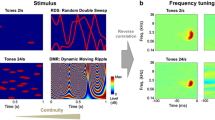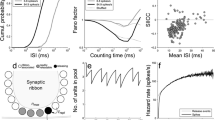Abstract
The spectro-temporal receptive field (STRF) of an auditory neuron describes the linear relationship between the sound stimulus in a time-frequency representation and the neural response. Time-frequency representations of a sound in turn require a nonlinear operation on the sound pressure waveform and many different forms for this non-linear transformation are possible. Here, we systematically investigated the effects of four factors in the non-linear step in the STRF model: the choice of logarithmic or linear filter frequency spacing, the time-frequency scale, stimulus amplitude compression and adaptive gain control. We quantified the goodness of fit of these different STRF models on data obtained from auditory neurons in the songbird midbrain and forebrain. We found that adaptive gain control and the correct stimulus amplitude compression scheme are paramount to correctly modelling neurons. The time-frequency scale and frequency spacing also affected the goodness of fit of the model but to a lesser extent and the optimal values were stimulus dependant.
Similar content being viewed by others
References
Aertsen AM, Johannesma PI (1981) The spectro-temporal receptive field. A functional characteristic of auditory neurons. Biol. Cybern. 42: 133–143.
Calhoun B, Schreiner C (1998) Spectral envelope coding in cat primary auditory cortex: Linear and non-linear effects of stimulus characteristics. European. J. Neurosci. 10: 926–940.
Cohen L (1995) Time-Frequency Analysis.Prentice Hall, Englewood Cliffs, New Jersey.
deCharms RC, Blake DT, Merzenich MM (1998) Optimizing sound features for cortical neurons. Science 280: 1439–1443.
Depireux DA, Simon JZ, Klein DJ, Shamma SA (2001) Spectro-temporal response field characterization with dynamic ripples in ferret primary auditory cortex. J. Neurophysiol. 85: 1220–1234.
Dooling RJ (1982) Auditory perception in birds. In: DE Kroodsma, EH Miller, eds. Acoustic Communication in Birds, pp 95–130.
Eggermont JJ, Johannesma PM, Aertsen AM (1983a) Reverse-correlation methods in auditory research. Q. Rev. Biophys. 16: 341–414.
Eggermont JJ, Aertsen AM, Johannesma PI (1983b) Prediction of the responses of auditory neurons in the midbrain of the grass frog based on the spectro-temporal receptive field. Hear. Res. 10: 191–202.
Elhilali M, Fritz JB, Klein DJ, Simon JZ, Shamma SA (2004) Dynamics of precise spike timing in primary auditory cortex. J. Neurosci. 24: 1159–1172.
Escabi MA, Schreiner CE (2002) Nonlinear spectrotemporal sound analysis by neurons in the auditory midbrain. J. Neurosci. 22: 4114–4131.
Escabi MA, Miller LM, Read HL, Schreiner CE (2003) Naturalistic auditory contrast improves spectrotemporal coding in the cat inferior colliculus. J. Neurosci. 23: 11489–11504.
Gentner TQ, Margoliash D (2003) Neuronal populations and single cells representing learned auditory objects. Nature 424: 669–674.
Ghazanfar AA, Nicolelis MA (2001) Feature article: The structure and function of dynamic cortical and thalamic receptive fields. Cereb. Cortex. 11: 183–193.
Gleich O, Manley GA (2000) Hearing Organ of Birds and Crocodilia. In Comparative Hearing: Birds and Reptiles RJ Dooling, RR Fay, AN Popper, eds., Springer-Verlag, New-York: pp 70–138.
Hsu A, Borst A, Theunissen FE (2004a) Quantifying variability in neural responses and its application for the validation of model predictions. Network 15: 91–109.
Hsu A, Woolley SM, Fremouw TE, Theunissen FE (2004b) Modulation power and phase spectrum of natural sounds enhance neural encoding performed by single auditory neurons. J. Neurosci. 24: 9201–9211.
Klein DJ, Depireux DA, Simon JZ, Shamma SA (2000) Robust spectro-temporal reverse correlation for the auditory system: Optimizing stimulus design. J. Comp. Neurosci. 9: 85–111.
Lewicki MS (2002) Efficient coding of natural sounds. Nat. Neurosci. 5: 356–363.
Lyon RF (1982) A computational model of filtering, detection and compression in the cochlea. In IEEE Int. Conf. Acoust., Speech and Signal Processing. Paris, IEEE, France.
Machens CK, Wehr MS, Zador AM (2004) Linearity of cortical receptive fields measured with natural sounds. J. Neurosci. 24: 1089–1100.
Mallat S (1989) A theory for multiresolution signal decomposition: the wavelet representation. IEEE Pattern Anal. and Machine Intell. 11: 674–693.
Marmarelis P, Marmarelis V (1978) Analysis of Physiological Systems. The White Noise Approach. Plenum, New York.
Okanoya K, Dooling RJ (1987) Hearing in passerine and psittacine birds: A comparative study of absolute and masked auditory thresholds. J. Comp. Psychol. 101: 7–15.
Painter T, Spanias A (2000) Perceptual Coding of Digital Audio. Proc. of IEEE 88: 451–513.
Palmer AR, Evans EF (1982) Intensity coding in the auditory periphery of the cat: Responses of cochlear nerve and cochlear nucleus neurons to signals in the presence of bandstop masking noise. Hear. Res. 7: 305–323.
Phillips DP (1990) Neural representation of sound amplitude in the auditory cortex: Effects of noise masking. Behav Brain Res. 37: 197–214.
Phillips DP, Hall SE (1987) Responses of single neurons in cat auditory cortex to time-varying stimuli: Linear amplitude modulations. Exp Brain Res. 67: 479–492.
Ruggero MA (1992) Physiology of the Auditory Nerve. In The Mammalian Auditory Pathway: Neurophysiology RR Fay, AN Popper, eds, pp. 34–93. Springer-Verlag, New-York.
Sachs MB, Abbas PJ (1974) Rate versus level functions for auditory-nerve fibers in cats: Tone-burst stimuli. J. Acoust. Soc. Am. 56: 1835–1847.
Schlauch RS, DiGiovanni JJ, Ries DT (1998) Basilar membrane nonlinearity and loudness. J. Acoust. Soc. Am. 103: 2010–2020.
Schreiner CE, Calhoun BM (1994) Spectral envelope coding in cat primary auditory cortex: Properties of ripple transfer functions. Auditory Neurosci. 1: 39–61.
Singh NC, Theunissen FE (2003) Modulation spectra of natural sounds and ethological theories of auditory processing. J. Acoust. Soc. Am. 114: 3394–3411.
Slaney M (1988) Lyon’s Cochlear Model. In Apple Technical Report: 1–79.
Stevens SS (1956) The direct estimation of sensory magnitudes: loudness. Am. J. Psych. 69: 1–25.
Theunissen FE, Sen K, Doupe AJ (2000) Spectral-temporal receptive fields of nonlinear auditory neurons obtained using natural sounds. J. Neurosci. 20: 2315–2331.
Theunissen FE, David SV, Singh NC, Hsu A, Vinje W, Gallant JL (2001) Estimating spatio-temporal receptive fields of auditory and visual neurons from their responses to natural stimuli. Network: Comp. Neural. Syst. 12: 1–28.
Von Békésy G (1960) Experiments in Hearing. McGraw-Hill.
Willmore B, Smyth D (2003) Methods for first-order kernel estimation: Simple-cell receptive fields from responses to natural scenes. Network 14: 553–577.
Woolley SM, Casseday JH (2004) Response properties of single neurons in the zebra finch auditory midbrain: Response patterns, frequency coding, intensity coding, and spike latencies. J. Neurophysiol. 91: 136–151. Epub 2003 Oct. 2001.
Yao J, Zhang YT (2002) The application of bionic wavelet transform to speech signal processing in cochlear implants using neural network simulations. IEEE Trans. Biomed. Eng. 49: 1299–1309.
Zevin JD, Seidenberg MS, Bottjer SW (2004) Limits on reacquisition of song in adult zebra finches exposed to white noise. J. Neurosci. 24: 5849–5862.
Author information
Authors and Affiliations
Corresponding author
Additional information
Action Editor: Israel Nelken
Rights and permissions
About this article
Cite this article
Gill, P., Zhang, J., Woolley, S.M.N. et al. Sound representation methods for spectro-temporal receptive field estimation. J Comput Neurosci 21, 5–20 (2006). https://doi.org/10.1007/s10827-006-7059-4
Received:
Revised:
Accepted:
Published:
Issue Date:
DOI: https://doi.org/10.1007/s10827-006-7059-4




